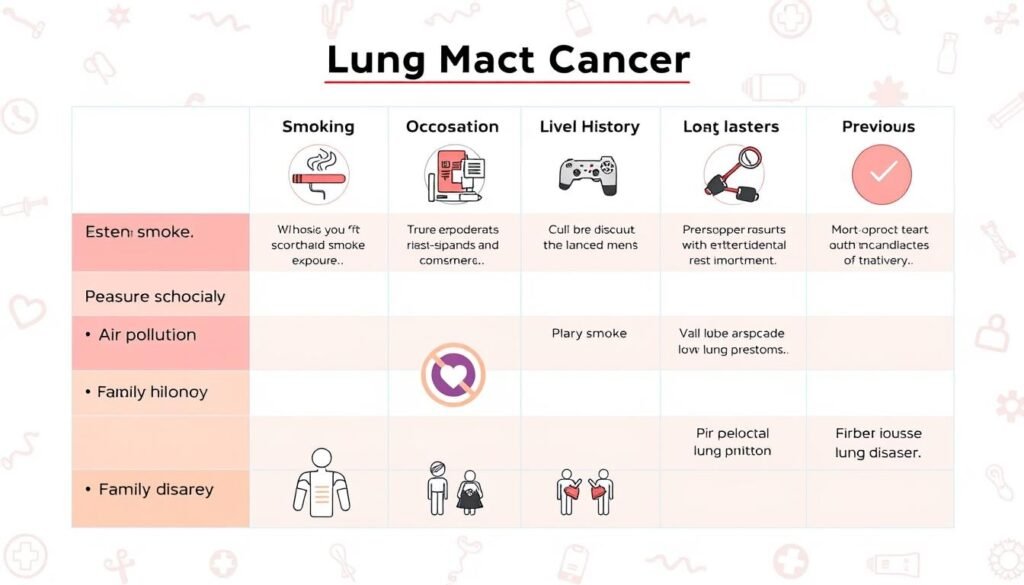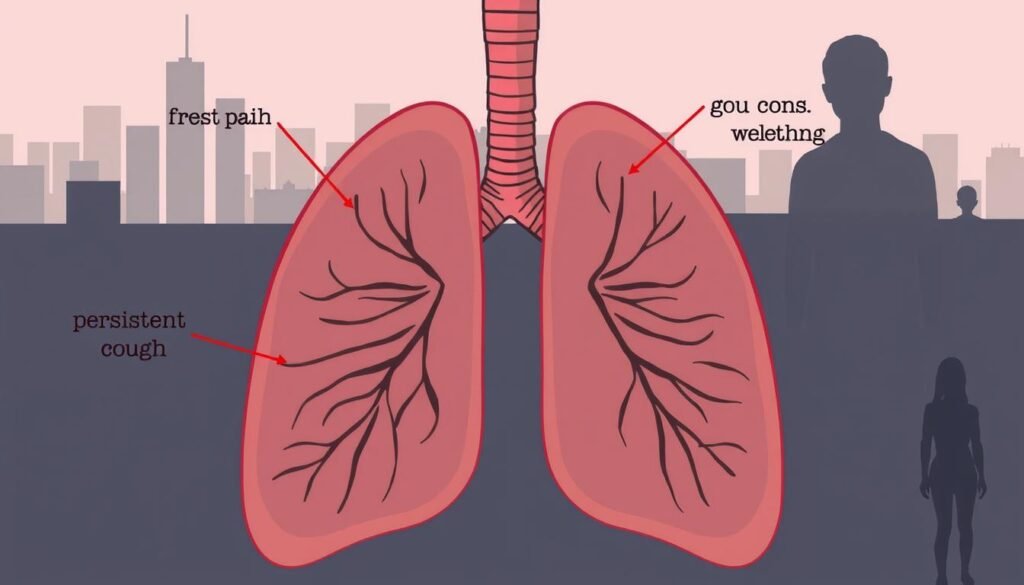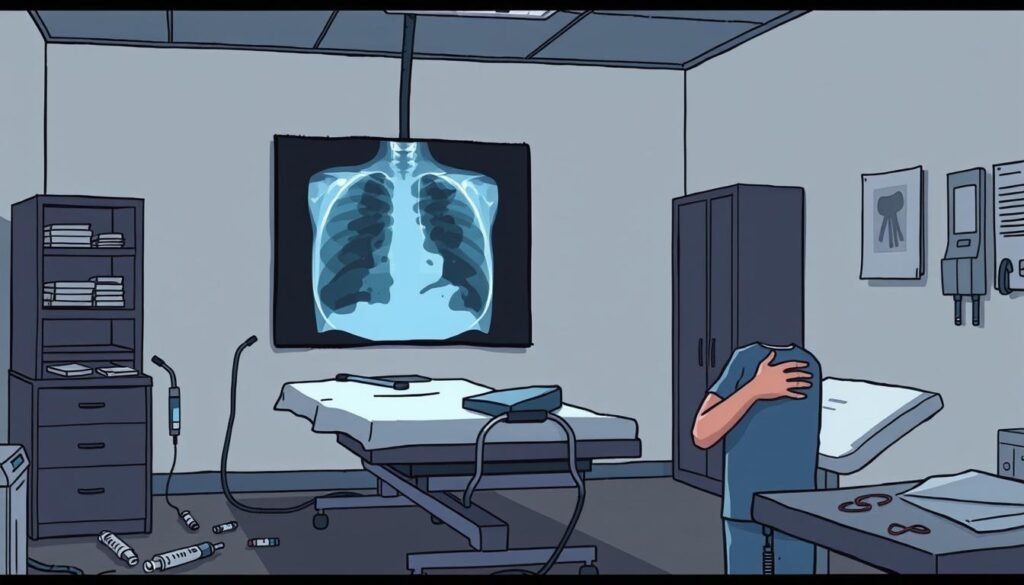Lung cancer causes about 25% of all cancer deaths in the U.S. Catching it early is key. Sadly, its early signs often go unnoticed, or are mistaken for minor issues. This piece highlights the need to spot early signs of lung cancer quickly. Signs like a constant cough, losing weight without trying, and feeling out of breath. Spotting these lung cancer symptoms early improves chances of successful treatment.
For those who smoke, paying attention to any unusual changes is vital. Knowing the signs and how crucial early detection is can help you take charge of your lung health. For more on the early symptoms to watch for, check this resource.
Key Takeaways
- Lung cancer is a leading cause of cancer deaths, making early detection critical.
- Common early signs include persistent coughing, unexplained weight loss, and shortness of breath.
- High-risk individuals, especially smokers, should monitor any unusual health changes.
- Being aware of lung cancer symptoms can facilitate timely diagnosis and treatment.
- Early intervention significantly improves health outcomes for lung cancer patients.
Understanding Lung Cancer
Lung cancer is a major health issue worldwide. It is the top cause of cancer deaths. This disease starts in the lung cells. These cells are essential for breathing and oxygen exchange. There are two main types of lung cancer. These are non-small cell lung cancer (NSCLC) and small cell lung cancer (SCLC).
NSCLC makes up about 85% of lung cancer cases. It usually grows slowly. On the other hand, SCLC is very aggressive and spreads fast.
Smoking is the biggest risk for lung cancer. Heavy smokers are at a high risk for SCLC. But stopping smoking can greatly lower this risk. It shows how key it is to be aware and make healthy choices. Also, being around secondhand smoke, radon gas, and certain work-related carcinogens adds to the risk. Those with lung cancer in their family should be extra careful.
Spotting lung cancer early is crucial. Understanding the early signs can help start treatment sooner. Lung cancer can lead to severe problems. These include painful breathing and coughing up blood. The cancer can also spread to other parts of the body. Finding it early and ongoing research are vital. They help improve how the lungs work in those affected and lead to better health results.
| Cancer Type | Characteristics | Prevalence |
|---|---|---|
| Non-Small Cell Lung Cancer (NSCLC) | Slower growing, includes types like squamous cell carcinoma and adenocarcinoma | Approximately 85% of lung cancer cases |
| Small Cell Lung Cancer (SCLC) | Aggressive, tends to spread quickly, typically occurs in heavy smokers | Less common than NSCLC |
Risk Factors for Lung Cancer
Lung cancer has several key risk factors. The most critical is smoking, causing about 80% of lung cancer deaths. Heavy smokers over many years face a high risk for small cell lung cancer. However, quitting smoking greatly reduces this risk, at any age.
Environmental exposure is also a big risk for lung cancer. Secondhand smoke is the third main cause of lung cancer in the U.S., affecting even non-smokers. Radon gas, which is natural and radioactive, is the second top cause among non-smokers. People working with harmful substances like asbestos and arsenic are at increased risk too. These jobs highlight the need for safety at work.
A family history of lung cancer can increase your risk. If you or your family have had lung cancer, or you’ve been exposed to radon or arsenic, your risk goes up. Knowing these risk factors can help people make better health choices and get tested often.

| Risk Factor | Description |
|---|---|
| Smoking | Leading cause of lung cancer; heavy smokers are particularly at risk. |
| Secondhand Smoke | Increases risk for non-smokers, makes up third most common cause. |
| Radon Exposure | Second-leading cause among non-smokers, is a naturally occurring gas. |
| Occupational Exposure | Working with carcinogens such as asbestos and nickel heightens risk. |
| Family History | Personal or family history can increase likelihood of developing lung cancer. |
| Radiation Therapy | Prior chest radiation for other cancers raises risk of lung cancer. |
| Environmental Pollutants | Air pollution, including diesel exhaust, can contribute to lung cancer deaths. |
Common Symptoms to Watch For
Spotting common lung cancer symptoms early is key to getting better. These symptoms might show up slowly and need your focus. If you’ve had a cough that won’t go away for more than two weeks, it’s time to check with a doctor. Coughing up blood or strange sputum are big warning signs. They mean you should get help right away.
Feeling short of breath and wheezing can also suggest lung cancer. These problems can happen when your airways are blocked or you have lung damage. Another red flag is losing weight without trying. This can happen with lung cancer and other serious diseases.
Other common lung cancer symptoms include:
- Persistent fatigue or weakness
- Recurrent respiratory infections
- Hoarseness or changes to the voice
- Chest pain, which may worsen with deep breaths or coughing
Knowing these symptoms helps you get care sooner. Catching the disease early can lead to better treatment results. Writing down any ongoing symptoms can help your doctor figure out what’s wrong faster.

| Common Symptoms | Description |
|---|---|
| Persistent Cough | A cough that lasts more than two weeks and does not improve. |
| Coughing Up Blood | Hemoptysis, or blood in sputum, can indicate serious health issues. |
| Shortness of Breath | Difficulty breathing or wheezing that may signify obstructions in the airways. |
| Unexplained Weight Loss | Loss of weight without trying, signaling potential malignancy. |
| Chest Pain | May be felt as discomfort that worsens with breathing or coughing. |
| Persistent Fatigue | Extreme tiredness that doesn’t get better with rest. |
Recognizing the Early Signs of Lung Cancer
Understanding the early signs of lung cancer can help a lot. It can make a big difference for patients. Knowing these signs early can lead to getting help sooner.
A persistent cough that won’t go away
If you have a cough that doesn’t stop after a few weeks, pay attention. This could mean there are deeper issues. Talk to a doctor if you have a persistent cough. It might be an early sign of lung cancer.
Coughing up blood or rust-colored sputum
Coughing up blood is a serious issue. This needs immediate medical attention. It could be related to lung cancer or other conditions. If this happens, see a doctor right away to find out the cause.
Shortness of breath and wheezing
Having trouble breathing can have many causes. But, don’t ignore it if it’s new. It might be an early warning of lung cancer. Anyone with ongoing breathing issues should see a doctor. More info on these symptoms is available here.
Advanced Symptoms of Lung Cancer
As lung cancer gets worse, advanced lung cancer symptoms can become more obvious. Knowing these signs is key for getting help early and improving the outcomes. Patients may deal with symptoms that greatly change their quality of life.
Chest pain that worsens with deep breathing
Signs of advanced lung cancer include chest pain. This pain gets worse with deep breaths, coughing, or laughing. It suggests the tumor has grown and may be affecting areas around it. Constant pain can change how patients live as they look for ways to feel better.
Fatigue and unexplained weight loss
Experiencing severe fatigue that rest won’t fix is another common sign. This, along with unexplained weight loss, raises alarms. These signs often mean the body is fighting hard against the cancer. It’s important to check these symptoms out to find what’s causing them.

Other common signs include a ongoing cough, coughing up blood, and a loss of interest in eating. If someone has several symptoms, seeing a healthcare professional is crucial. They can make a correct diagnosis and recommend the right treatment. Early detection of these symptoms can lead to better management and care. More information on lung cancer symptoms is available here: lung cancer signs and symptoms.
| Symptoms | Description |
|---|---|
| Chest Pain | Pain in the chest that worsens with deep breathing, coughing, or laughing. |
| Fatigue | Constant tiredness that does not improve with rest. |
| Weight Loss | Unexplained weight loss often associated with the disease’s progression. |
| Persistent Cough | A cough that does not go away and may produce blood. |
| Loss of Appetite | A noticeable decrease in desire to eat. |
The Importance of Early Detection
Finding lung cancer early is key to helping patients live longer. Every year, about 224,000 people get diagnosed, and 158,000 die from it. Screening tests like LDCT have been a game-changer. They cut the number of lung cancer deaths by 20% compared to old methods.
If you’re at high risk, like a smoker or have lung cancer in your family, getting checked is vital. The NLST study showed 63% of cancers found with LDCT were caught early. This early catch boosts the chance of living five more years to almost 90%. Early screening makes a huge difference, allowing treatments to start sooner.
To save one life from lung cancer, 320 people at high risk need to be screened with LDCT. Doing this could stop 12,250 lung cancer deaths every year. LDCT is better than the usual chest X-rays at finding tumors in those at high risk.
More people now have access to LDCT thanks to Medicare covering it for those who qualify. Fast action is also key at UF Health Lung Cancer Program. Here, 90% of lung cancer referrals get seen within a week. This highlights how crucial it is to move quickly with a possible diagnosis.
| Statistic | Details |
|---|---|
| New Cases (2016) | 224,000 |
| Deaths (2016) | 158,000 |
| 5-Year Survival Rate | 18% overall; 90% for stage I |
| Mortality Reduction via LDCT | 20% decline |
| Stage I Diagnosis Rate (NLST) | 63% |
| Annual Deaths Averted if LDCT Implemented | 12,250 |
Methods of Cancer Screening
Cancer screening is key in finding lung cancer early, especially for smokers or others at high risk. Low-dose computed tomography (CT) scans are better at spotting tumors early compared to chest X-rays. Catching lung cancer early, when it’s easiest to treat, can make a big difference.
Standard imaging techniques
We use many imaging techniques for lung cancer screening:
- Low-dose CT scans: These scans spot lung nodules and early cancer with less radiation than regular CT scans.
- Magnetic Resonance Imaging (MRI): MRIs are critical for checking if cancer has spread to the brain or spinal cord.
- Positron Emission Tomography (PET) scans: When combined with CT scans, PET scans help understand how far cancer has spread.
- Bone scans: These tests show if lung cancer has moved to the bones, guiding treatment plans.
- Bronchoscopy: This lets doctors see and take samples from suspicious areas in the lungs.
Role of annual check-ups for high-risk individuals
Yearly health check-ups matter a lot for those at high risk for lung cancer. People between 50 and 80 with a history of heavy smoking should get yearly low-dose CT scans, says the U.S. Preventive Services Task Force. These visits let doctors judge risk, suggest screening, and watch lung health. Starting screening early can find cancer soon enough to treat it effectively. To learn more about lung cancer screening, check out these guidelines.
Lung Cancer Types and Their Symptoms
Lung cancer is mainly divided into two kinds: non-small cell lung cancer (NSCLC) and small cell lung cancer (SCLC). Knowing the differences between these types and their symptoms is crucial. This knowledge helps in getting the right medical help early.
NSCLC makes up about 85% of lung cancer cases. In the U.S., adenocarcinoma is the most seen form of NSCLC. People with NSCLC might start to notice symptoms slowly over time. These symptoms can be:
- Persistent cough
- Coughing up blood
- Chest pain
- Difficulties with breathing
- Fatigue
- Unexplained weight loss
- Hoarseness
- Wheezing
SCLC grows quickly and is mostly caused by smoking. Its symptoms can start suddenly and be intense. People may experience:
- Shortness of breath
- Chest pain
- Weakness and fatigue
- Frequent respiratory infections
- Loss of appetite and unexplained weight loss
As SCLC advances, it can lead to more issues like paraneoplastic syndromes. These affect the nervous and endocrine systems. People might see muscle weakness and changes in hormones.
Knowing whether you have NSCLC or SCLC and the symptoms they bring is important. It helps you talk better with your doctor and get the right treatment faster. This can make a big difference in dealing with the disease.
| Type of Lung Cancer | Common Symptoms |
|---|---|
| Non-Small Cell Lung Cancer (NSCLC) | Persistent cough, coughing up blood, chest pain, hoarseness, difficulty breathing |
| Small Cell Lung Cancer (SCLC) | Shortness of breath, unexplained weight loss, chest pain, fatigue, recurrent infections |
Conclusion
Raising awareness of lung cancer is vital for better health outcomes. Lung cancer causes the most cancer deaths in the US. Knowing early symptoms can make a big difference in survival.
People need to know signs like ongoing cough, weight loss, and tiredness. These could mean lung cancer is there. This calls for a quick check-up by a doctor.
Studies show symptoms can appear six months before finding out you have cancer. This means being alert and acting fast on health changes is key. Even with few people getting screened, checking at-risk folks early can help. It can lead to better treatments and longer lives.
To wrap up, teaching about lung cancer empowers everyone. It makes them proactive about their health. Knowing the early signs and risks helps with better lung health. It also saves lives.